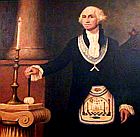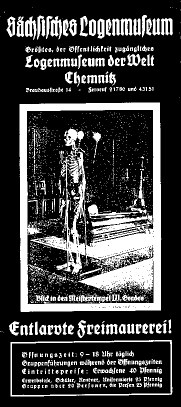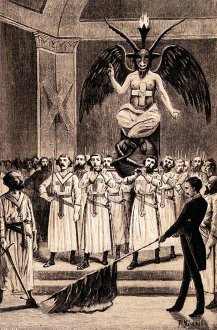Freemasonry
Today, apart from their occasional appearance in a Monty Python sketch, or the popular theory that Jack the Ripper was one, Masons pass unnoticed by the general public. But this wasn't always so.
In 1827, the United States witnessed the birth of a third political party. This had never happened before. The new party offered America its first alternative to the two dominant political groups. Like so many third parties to come, this one had a rather narrowly-focused platform. It was dedicated to countering the malevolent and subversive influence of the international cabal known to the world as Freemasonry. It was named the Anti-Masonic Party, and the Anti-Masons were well aware that theirs was an uphill battle.
 America's first President, George Washington, had been a Mason. So were many other Founding Fathers, including Ethan Allen, John Paul Jones, Paul Revere, John Hancock, and Benjamin Franklin. Eight of the 56 signatures on the Declaration of Independence belonged to avowed Masons, as well as nine on the Constitution.
America's first President, George Washington, had been a Mason. So were many other Founding Fathers, including Ethan Allen, John Paul Jones, Paul Revere, John Hancock, and Benjamin Franklin. Eight of the 56 signatures on the Declaration of Independence belonged to avowed Masons, as well as nine on the Constitution.
In 1832, the Anti-Masonic Party managed to elect Millard Fillmore to Congress, but their candidate for President received only seven votes in the Electoral College. He was crushed by Andrew Jackson... who was a Mason.
Freemasons claim that their group dates back to the stonemason guilds of the Middle Ages, some even say it reaches back to the building of King Solomon's Temple in 850 B.C. No one really believes that. It was actually founded in 1717 by a bunch of affluent Englishmen with too much time on their hands. The organization flourished and spread rapidly throughout the British empire; Masonic lodges appeared in the American colonies as early as the 1730s. A separate strain later popped up in France and swept across Europe.
It was a fraternity of sorts, attracting the community's best and brightest. They would gather together for strange and secret rituals, swearing oaths of allegiance to the brotherhood and each other. Naturally, it became a place for negotiating business deals and the exchange of gossip. The fraternity was soon a major power center in any large city, and the international network of lodges constituted an immense, wealthy, and well-connected supragovernmental organization.
As such, it took almost no time at all for the the backlash to begin. The Roman Catholic church was officially opposed to the group ever since 1738, when Pope Clement XII condemned Freemasonry and banned it from his faith. Catholics were forbidden from joining, under pain of excommunication. In 1825, Leo XII reiterated the ban and declared it to be permanent and everlasting. In 1884, Leo XIII called on each member of the clergy to get the word out and help defeat this insidious foe:
We pray and beseech you, venerable brethren, to join your efforts with Ours, and earnestly to strive for the extirpation of this foul plague, which is creeping through the veins of the body politic. [...] We wish it to be your rule first of all to tear away the mask from Freemasonry, and to let it be seen as it really is; and by sermons and pastoral letters to instruct the people as to the artifices used by societies of this kind in seducing men and enticing them into their ranks, and as to the depravity of their opinions and the wickedness of their acts.
In his encyclical, Leo pointed out that the Masons were in cahoots with the Socialists and Communists. Quizzically, he omitted the Jews. Perhaps it escaped his mind. Leo also referred to the fact that Masons believed in such demonic notions as democracy, free elections, the rule of law, and the separation of church and state.
This opposition to Freemasonry persisted into the 20th century. Pope Pius XII hated them.
 Freemasons suffered harshly in Nazi Germany. Adolf Hitler firmly believed that they had been completely subverted by the Jews, as described in The Protocols of the Elders of Zion. As he explained in his bestselling autobiography Mein Kampf, the Masons had been subverted to provide a mask of legitimacy for the diabolical Jew:
Freemasons suffered harshly in Nazi Germany. Adolf Hitler firmly believed that they had been completely subverted by the Jews, as described in The Protocols of the Elders of Zion. As he explained in his bestselling autobiography Mein Kampf, the Masons had been subverted to provide a mask of legitimacy for the diabolical Jew:
[I]n Freemasonry, which has succumbed to him completely, he has an excellent instrument with which to fight for his aims and put them across. The governing circles and the higher strata of the political and economic bourgeoisie are brought into his nets by the strings of Freemasonry, and never need to suspect what is happening.
Accordingly, the Nazis made it one of their top priorities to uproot the organization. The government seized Masonic temples, jailed their membership, and otherwise made life very difficult for anybody attached to the group. In fact, it was Adolf Eichmann's first assignment in the SS to track the activities of suspected Masons.
The greatest dictators of recent decades have jumped on the Anti-Masonic bandwagon: Stalin, Mussolini, Franco, Pinochet (Chile), Salazar (Portugal)... not to mention all the conspiracy kooks.
There are many who claim that the Freemasons grew out of the medieval organization known as the Knights Templar. Today, the Knights Templar exists as one branch of the interconnected organizations making up Freemasonry.
When a new member joins, his initial ranks in the organization are referred to the Blue Lodge. This culminates in the designation of "Master Mason." At which point, the newly-minted Mason faces a choice: pursue either the Scottish Rite or the York Rite. Men who choose the York Rite eventually have the option of joining the Knights Templar.
Why They Are Hated And Feared
But why do the Masons have so many enemies? Historically, the group has been attacked for a variety of reasons.
- The Freemasons secretly rule the world.
Or, more precisely, the usual claim is that the Freemasons are the visible arm of the Illuminati, who actually rule the world. The founder of the Bavarian Illuminati, Adam Weishaupt, was also a Mason. This fact prompted wide speculation that the two groups had been (or still are) working in tandem for a broader objective -- the establishment of a "New World Order." This notion is still widely believed, especially among the militia types.
But how sneaky can this society possibly be, if you can purchase any of their tchotchkes through eBay? Last time we checked, there were 3,204 auctions matching the query: masonic,freemasonry,freemasons. In addition to the standard fezzes, aprons, trowels, rings, and printed literature, there's a seemingly endless parade of gaudy souvenirs:
ashtrays, ballpoint pens, bath towels, beer bottles, beer mugs, bells, belt buckles, bottle stoppers, bumper stickers, bolo ties, bookends, bookmarks, bowties, buttons, candles, canes, cigarette cases, collapsible umbrellas, combs, commemorative plates, cufflinks, cutlery, decals, decanters, door knockers, doorknobs, drawer pulls, earrings, embroidered patches, figurines, flags, flasks, gavels, goblets, golf balls, hat pins, ice cream molds, jewelry of all kinds, keyrings, lamps, lapel pins, leather belts, leather wallets, letter openers, license plates, license plate holders, lightbulbs, lighters, magnets, medallions, medals, miniature replicas of the ark of the covenant, money clips, paperweights, pillboxes, pocket knives, polo shirts, postage stamps, postcards, potholders, radiator caps, rubber stamps, silver ingots, shot glasses, socks, statuettes, straight razors, sundials, suspenders, swords, teddy bears, thermometers, thimbles, tie clasps, tobacco pipes, tokens, travel alarm clocks, travel mugs, tumblers, wall clocks, wall hangings, watch fobs, windbreakers, wristwatches...
Or, if you'd prefer brand new merchandise instead of hand-me-downs, try contacting any of the hundreds of retail sites listed in Google under fraternal supply. Almost all of them sell Masonic crap. Just keep contacting them until you find one that doesn't care whether you belong to a Lodge.
- The Freemasons are Satanic, or at least anti-Christian.
 Jack Chick promotes this idea. Many fundamentalist Christians believe that Masons are required to pledge themselves to Freemasonry above and beyond their religious faiths. This would be a strict no-no for the Jesus freaks, if it were true. Which it isn't.
Jack Chick promotes this idea. Many fundamentalist Christians believe that Masons are required to pledge themselves to Freemasonry above and beyond their religious faiths. This would be a strict no-no for the Jesus freaks, if it were true. Which it isn't.
But then, you can hardly blame them. We're talking about a bunch of people living under the specter of intergenerational suffering (according to Exodus 20:4-5):
You are strictly prohibited from the manufacture of graven images resembling anything found in heaven above, within the Earth, or dwelling in the waters underneath the Earth. Neither will you bow down before such images or serve them; because, as your god Yahweh, I am easily excitable and will not hesitate to punish sons for the misdeeds of their fathers, all the way to the third and fourth generations.
Which is also why the Jehovah's Witnesses refuse to say the Pledge of Allegiance. Better safe than sorry, especially when you're talking about eternal torment for you and your extended progeny.
Some even believe that Freemasonry is itself a religion, whose deity is the pagan god Baphomet.
The problem is, as any devout Christian in the organization will tell you, there is nothing Satanic about the group's ideology, rituals, or symbols. But the nutballs have an answer for this. The Masons don't believe that their group is anti-Christian because only the innermost, core members know the truth. Meaning: inside the secret club is another, even more secret, club.
- The Freemasons are controlled by the Jews.
Already discussed that. Hitler, The Protocols, etc.
Contributing to the sinister reputation are all of their freaky ceremonies. The Masons are very proud of their rituals, which have been copied innumerable times.
One longstanding sore point for the Masons has been the plagiarization of Masonic ceremonies and symbology by Joseph Smith for his religious cult known as the Mormon Church. Smith was inducted into the brotherhood in March 1842. In May he produced the Endowment ceremony, which borrowed whole sections of dialogue from the Masonic ritual. This pissed off a lot of Freemasons, to say the least. Like every Mason, Smith had been required to swear an oath never to reveal the secrets of Freemasonry to non-members, under pain of death. Oh well. Evidently tired of taking crap from the Masons, the Mormons finally excised the offending elements from their ceremony in 1990.
One prominent 19th century Mason was Albert Pike. He was an officer in the Confederate army during the Civil War, who later went on to become a big deal in Freemasonry. He wrote seminal books which are still read today by the Freemasons.
He was also evidently a big fat racist, writing editorials in his newspaper inveighing against the Negroes and so forth. It is widely-believed but poorly documented that Pike might have been one of the original founders of the Ku Klux Klan. The Masons vehemently deny this, of course.

Recognizable Masons
- Benedict Arnold, Revolutionary War traitor.
- Napoleon Bonaparte, French tyrant.
- Henry Ford, auto manufacturor, racist.
- Barry Goldwater, Senator.
- Jesse Helms, Senator, homophobe.
- J. Edgar Hoover, FBI director-for-life, homosexual.
- Houdini, magician.
- Joseph Smith, founder of the Mormon Church.
- Brigham Young, another Mormon.
- Oscar Wilde, noted author and homosexual.
- Mark Twain, American author.
- John Glenn, astronaut.
- Samuel Hahnemann, started the Homeopathy fraud.
- Charles Lindbergh, aviator, racist.
- All seven of the Ringling Brothers.
- Colonel Sanders, fat fried chicken tycoon.
- Dave Thomas, fat Wendy's tycoon.
- Telly Savalas, player.
- Peter Sellers, pink panther.
- Strom Thurmond, racist US Senator.
- William Walker, advocate of Manifest Destiny.
- Sir Winston Churchill, Prime Minister of Britain.
- Aleister Crowley, the most evil man that ever was, 33rd degree.
- U.S. Chief Justice Earl Warren, head of the Warren Commission.
- Roberto Calvi, Vatican banker.
- Abraham Zapruder, filmed John F. Kennedy assassination.
Masons had an impressive (and to some, alarming) role in the founding the United States, including most of the critical Founding Fathers:
- George Washington
- John Hancock.
- Patrick Henry, Give me Liberty or give me Death. Some claim that he was never a Mason.
- Benjamin Franklin, inventor, printer, diplomat, patriot, womanizer. Arguably the most accomplished American that has ever lived.
- Paul Revere
- Ethan Allen
- Thomas Jefferson, likely a Mason.
Additional Presidents who were Masons
- Gerald Ford
- William McKinley, assassinated by an anarchist.
- James Garfield, assassinated President.
- Theodore Roosevelt
- Franklin D. Roosevelt
- Harry S Truman
- Warren G. Harding
- William Howard Taft, the fattest President.
- Andrew Johnson, the first impeached President.
- James Monroe
- Andrew Jackson
- James Knox Polk
- James Buchanan, the only bachelor US President.
- Lyndon B. Johnson was a first degree Mason.
- Ronald Reagan was an honorary Scottish Rite Mason, but not a Freemason.
Timeline
| 15 Mar 1842 |
Joseph Smith is initiated into the Freemasons. The very next night, he will be promoted to the rank of Master Mason. |
| Mar 1935 |
According to Joseph Goebbels, the Soviet Union's recent inclusion in the League of Nations was engineered by 300 "members of the Jewish race and conspirators of Freemasonry." |
|

 America's first President, George Washington, had been a Mason. So were many other Founding Fathers, including Ethan Allen, John Paul Jones, Paul Revere, John Hancock, and
America's first President, George Washington, had been a Mason. So were many other Founding Fathers, including Ethan Allen, John Paul Jones, Paul Revere, John Hancock, and  Freemasons suffered harshly in Nazi Germany.
Freemasons suffered harshly in Nazi Germany. 